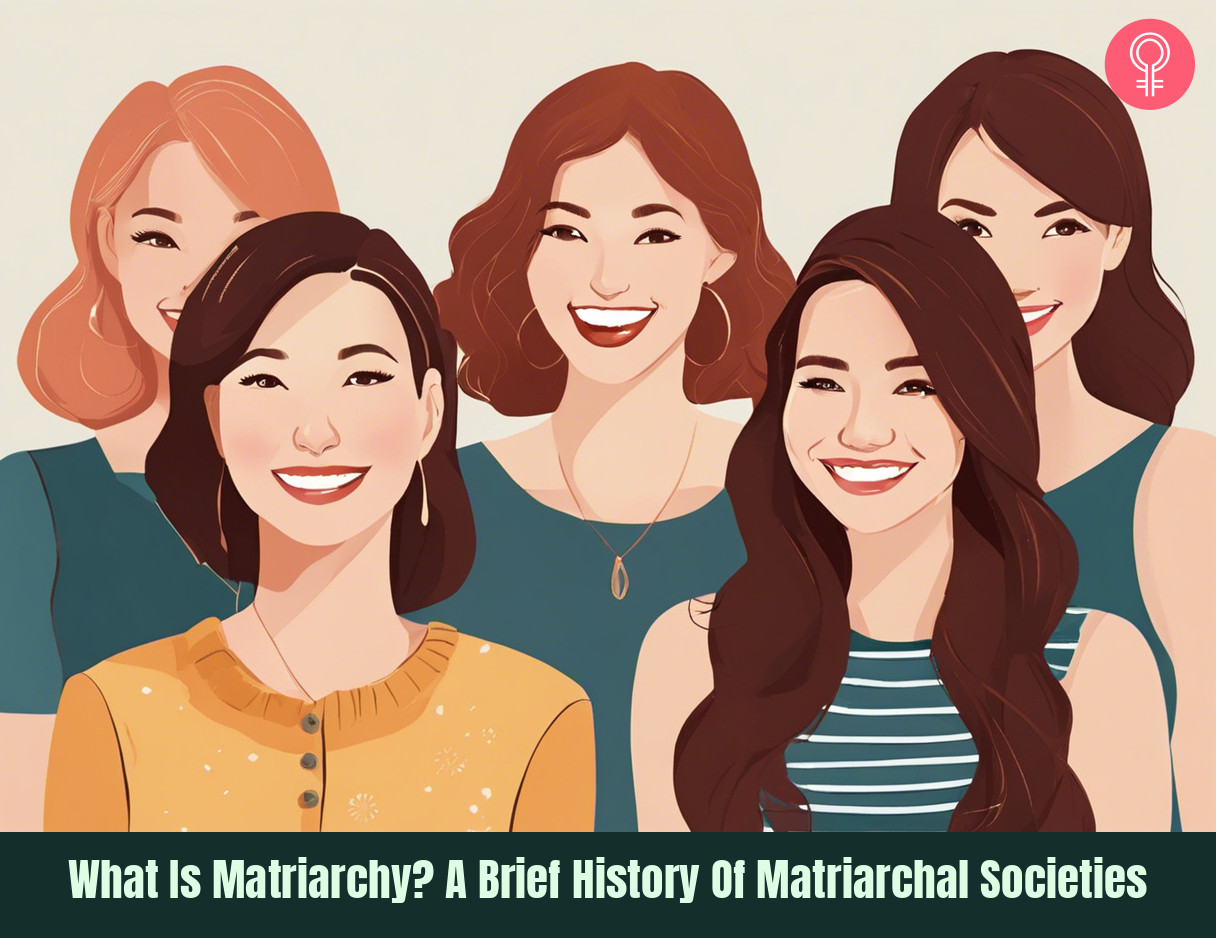What Is Matriarchy? A Brief History Of Matriarchal Societies
Understand everything about women dominating or governing societies around the world.

Image: Shutterstock
A society where the female member leads a family is called matriarchy, and the female head of the family is called the matriarch. For a long time, men have dominated the better portion of society. However, there have always been cultures where women were in charge of things; they dominated families and society and were at the core of everything.
The concept of a society where women govern the political, social, and economic institutions may sound far-fetched to some. Yet, history shows that matriarchal communities have existed throughout centuries, and some still exist now. In this article, we explain what a matriarchal society is, how it functions, and more. So, what are you waiting for? Let’s dig into it.
In This Article
The Significance Of Matriarchy
Contrary to what you might think, matriarchy is not a system where women control and lord over men. As Heidi Goettner-Abendroth, the founder of the International Academy HAGIA for Modern Matriarchal Studies, put it to Dame Magazine:
“The aim is not to have power over others and nature, but to follow maternal values, i.e., to nurture the natural, social, and cultural life based on mutual respect.”
In other words, matriarchy is a system that revolves around the principle of mother-rule in which mothers or females are at the top of the power structure or hierarchy. They dominate in roles of moral authority, political leadership, social privilege, and control of property. For a social system to be viewed as a matriarchy, it would need the support of a culture-defining women’s dominance as desirable and legitimate or believing in feminism.
A Brief History Of Matriarchy
While anthropologists question the existence of a true matriarchal society, there is a school of thought that believes that human society was originally matriarchal. During a period known as the ‘Gynocratic Age,’ women were allegedly worshipped for their ability to give birth. At this point, childbirth was a huge mystery, and men, not realizing that they actually played a part in it, held the belief that women “bore fruit like trees when they were ripe.” (We’re talking about a really long time ago.) Allegedly, the Gynocratic Age lasted from around 2 million years ago to 3000 BCE. Then, it is said that a grand transformation occurred, perhaps due to a groundbreaking discovery or a cataclysm, that sparked patriarchy.
Archaeologists and researchers have stumbled across evidence that supports the theory that gynocratic or matriarchal societies may have once existed. In the fall of 2016, an 8,000-year-old sculpture was discovered in Central Turkey of some sort of goddess. It is speculated that the statue depicts a fertility goddess, while others believe her plump figure represents a woman of social prominence. We also need to keep in mind that even literature such as the Bible and The Odyssey highlight the significance of women in society.
 Trivia
TriviaHowever, skeptics point out that just because women were described as goddesses in ancient literature and artwork does not necessarily mean they were more powerful than men. The thing is with no written historical records, we can never be 100% sure about the legitimacy of a truly matriarchal society.
Difference Between Matriarchal And Matrilineal Societies
The term ‘matriarchy’ is often mixed up with the similar term ‘matrilineal.’ However, the two have notable differences. As we discussed earlier, ‘matriarchal’ refers to a society that is governed or controlled by women, while the anthropological term ‘matrilineal’ only denotes lineage. Children are identified in terms of the lineage of ancestors from the mother’s side rather than the father’s. They also inherit property through the female line. Also, tribal alliances and extended families form along female bloodlines.
These are some differences between matriarchal and matrilineal societies. However, since the inception of human civilization, we have known most of the society to be more commonly patriarchal. Let us now find out the differences between patriarchy and matriarchy in the next section.
Patriarchy And Matriarchy
A patriarchal social system is one in which men dominate in positions of privilege, leadership, and power and set social norms. On the other hand, a matriarchal society places women at the center of the political, social, and familial spheres. Rigid gender norms are frequently enforced by patriarchy, which limits women’s chances and gives men the upper hand in a variety of fields. Both systems have complexities that impact cultural paradigms and gender dynamics. In an effort to create a fair social structure, inclusiveness opposes these paradigms by promoting shared authority and equal representation for all people, regardless of gender.
 Quick Tip
Quick TipSo What In The World Is Matrifocality?

A family is considered to be ‘matrifocal’ if the mother heads the family without the presence of the father. Single-parent families headed by women, for example, are matrifocal since the mother plays a more important role at home and in the upbringing of the children.
Examples Of Matrilineal And Matriarchal Societies Around The World
Matriarchal societies exist around the world even today. Below are four diverse examples of female-led and matrilineal cultures from ancient times to today. Let’s take a look at the ways in which women ruled and continue to do so.
1. Umoja, Kenya
The Swahili word ‘Umoja’ means ‘unity’ or ‘oneness.’ Umoja in Samburu, northern Kenya is home to survivors of gender-based violence, female genital mutilation, and sexual assault. The matriarch of Umoja, Rebecca Lolosoli founded this village in 1990 with about 15 survivors of rape at the hands of British soldiers. The area is surrounded by a thorn fence to keep out men. In fact, this is a community where men are forbidden. The women learn trades, teach children, sell handicrafts like jewelry, and show tourists around a cultural center. They also educate women in the neighboring villages on their rights.
2. Mosuo, China
In the far eastern foothills of the Himalayas exists a lush valley in south-west China. Mosuo’s culture is rooted in a matrilineal set-up where the family lineage of individuals is traced through the female line. Each household is ruled by an ‘ah mi’ (mother or an elderly female), who also makes important decisions related to business. In Mosuo, there is no institution of marriage. Rather, women choose their partners by literally walking to the man’s home. Mosuo women are free to offer or accept sexual relations with a male, and the men are allowed to do likewise. Rejection and offering are in no way stigmatized.
The couples never live together, and the child always remains in the mother’s care with little to no role of the father in the child’s upbringing. So, it comes as no surprise that Mosuo is also known as the ‘Kingdom of Women.’
3. Khasi, India
Meghalaya, a state in the northeastern part of India, is home to three tribes that practice kinship based on matrilineality. In the Khasi tribe, the youngest daughter inherits all the ancestral property, the children take their mother’s surname, and the men live in their mother-in-law’s home after getting married. Patricia Mukhim, a national award-winning social activist who edits the Shillong Times newspaper, says, “Matriliny safeguards women from social ostracism when they remarry because their children, no matter who the father was, would be known by the mother’s clan name. Even if a woman delivered a child out of wedlock, which is quite common, there is no social stigma attached to the woman in our society.” She adds that her society will not succumb to the dominant patriarchal system and gender oppression that exists in most of India.
4. Minangkabau, Indonesia
Made up of 4.2 million members, the Minangkabau ethnic group of West Sumatra, Indonesia is the world’s largest known matrilineal society today. In this obscure Muslim society, women rule the domestic realm while the men are involved in political and spiritual roles. However, it is the women who choose the clan chief and have the power to remove him if necessary. The tribal law requires all clan property to be held and bequeathed from mother to daughter.
Infographic: Books On Matriarchy
The concept of matriarchy may be confusing to many considering its many dynamics in different parts of the world. But thanks to some fantastic authors who have explained it through their well-knit stories revolving around matriarchy. So, whether or not you are a bibliophile, below is an infographic that you must check to find out about these outstanding works. Illustration: StyleCraze Design Team
There is still a large section of the intelligentsia that dismisses the notion of matriarchy. Cynthia Eller in her book, The Myth of Matriarchal Prehistory, says that the concept of matriarchy is false and in no way complements the feminist movement. She argued that equality and the rule of women are misplaced goals, and should be rejected altogether.
In a matriarchal setup, women are placed at the top of the power structure, have control over property, and follow maternal values. The woman in charge of these responsibilities is a matriarch. However, at the most fundamental level, matriarchy as a concept is certainly worthy of discussion, and there is so much we can learn from it today.
Frequently Asked Questions
Does a matriarch have to be a mother?
No. Family or clan matriarchs may also make decisions for their members as representatives of the matriarchal family.
Which Native American tribes were matriarchal?
Native American tribes that are matriarchal include the Hopi and Haudenosaunee.
Can matriarchy exist within a larger patriarchal society?
Yes, it can exist within a larger patriarchal society. Men may hold more power or authority in broader society, while women may hold it in their family or community.
Are matriarchal societies the opposite of patriarchal societies?
They are often seen as polar opposites, but they are not necessarily so. Matriarchal societies just represent an alternate society in which women hold more power and influence than men and prioritize different values and behaviors than patriarchal societies do.
Does matriarchy mean that men have no power or influence?
No, matriarchy does not necessarily mean that men have no power or influence. Men may have power and influence, but they may be subjected to different expectations and behaviors than in a patriarchal society.
Key Takeaways
- Matriarchy centers on the principle of mother-rule, where mothers or females stand right up there in the power structure.
- A school of thought believes human society was originally matriarchal. However, many differ with this.
- The term matriarchy is often confused with ‘matrilineal.’ However, the two have notable differences.

Image: Stable Diffusion/StyleCraze Design Team
Learn about matriarchy in detail from the following video, and also find examples of societies where women hold power and influence.
References
Articles on StyleCraze are backed by verified information from peer-reviewed and academic research papers, reputed organizations, research institutions, and medical associations to ensure accuracy and relevance. Read our editorial policy to learn more.
- The evolution of matrilineal social systems in fissiped carnivores
https://www.ncbi.nlm.nih.gov/pmc/articles/PMC6664139



























